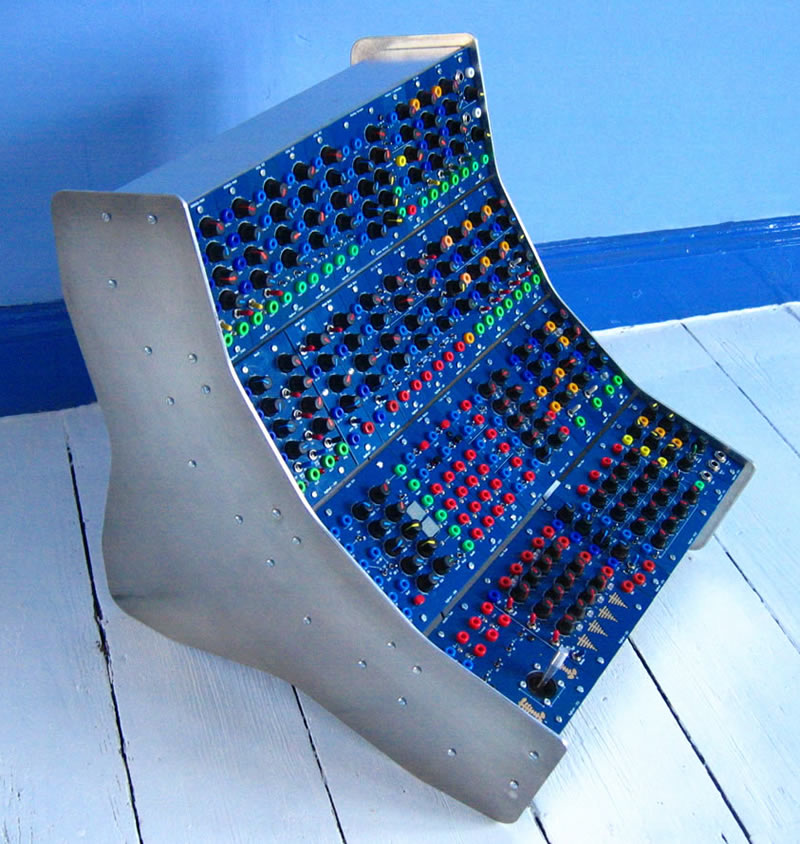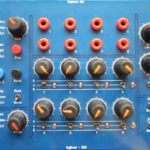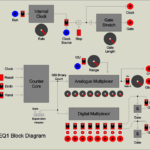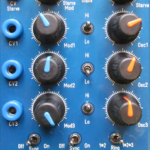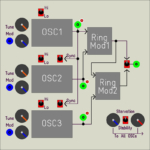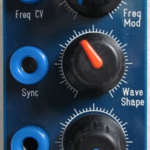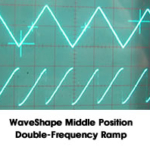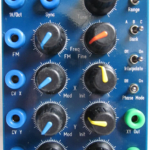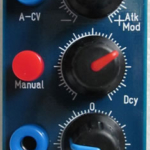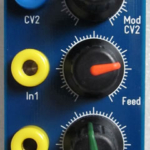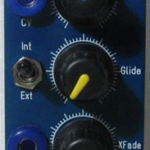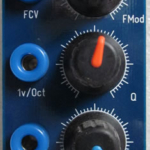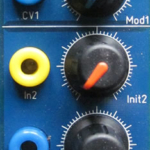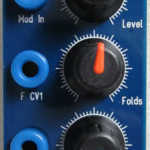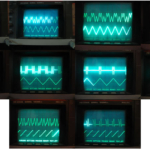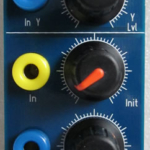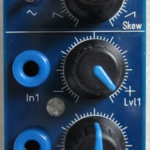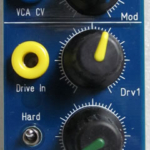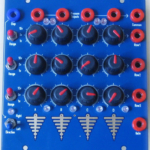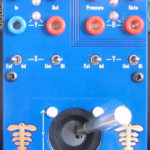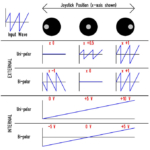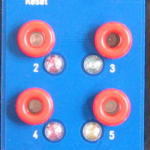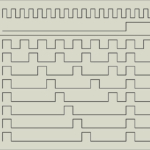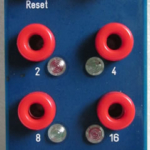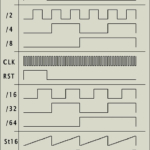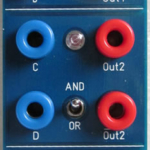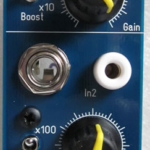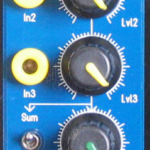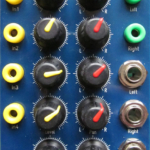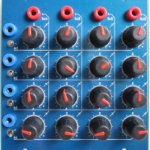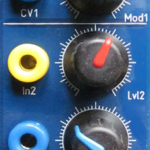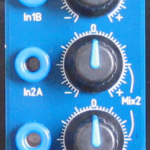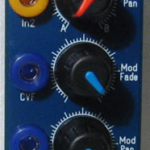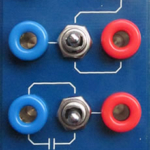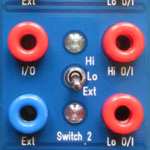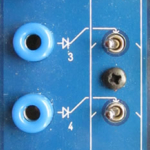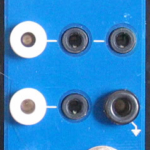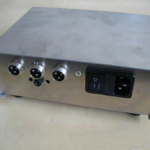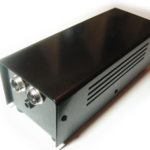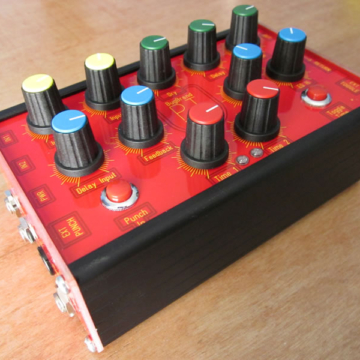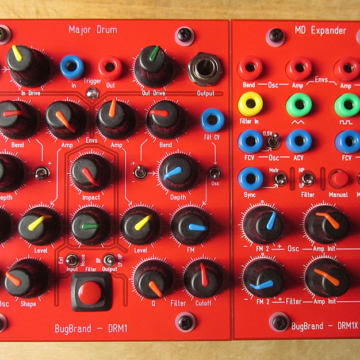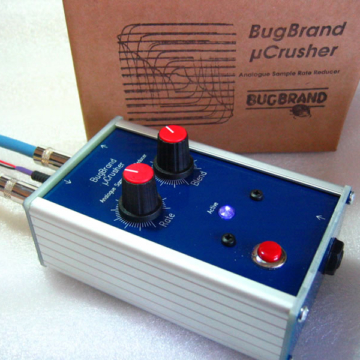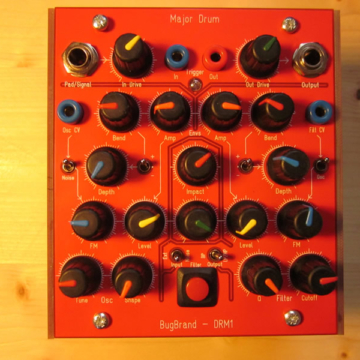Description
In 2009 I started introducing a range of Banana Frac modules & kept expanding the range until 2013 when I had to, due to life changes, draw a line under the ideas. The scope had grown beyond my initial dreams – where I’d imagined one or two frame systems, people were starting to build mega combos!
In 2016 I returned to modular via the pre-configured SynthVoice & have since again expanded the range of available modules – so the 2009-13 period has been rechristened as ‘The Old Blues’ to differentiate them from the current designs. It is important to note that while there are many fundamental similarities, I suggest keeping old & new designs as entirely separate systems – the aesthetics have been updated somewhat but the main reason is the power approaches. The old systems used external linear PSUs and, for various electronic reasons, may not function optimally on the DCDC power approach used on all designs today.
So the information here is just for archive interest – though many of the module ideas have since been updated for red & blue designs.
Below are images of many-but-not-all the modules – all modules show up on ModularGrid.
- SEQ1 – Sequence Hub
- SEQ1 Block
- SYN1 – Weevil
- SYN1 Block
- SYN2A – Utility VCO
- SYN2A Waveforms
- E350 – Morphing Terrarium
- ENV1 – Envelope
- PRC1 – PT Delay
- PRC2 – BugCrusher
- PRC3A – SV Filter
- PRC4 – Dual LPG
- PRC5 – Wavefolder
- PRC5 Waves
- DD1 – RingMod/LPG
- DD2 – LFO/Mix
- DD3 – VCA/Drive
- CTL1 – Touch Panel
- CTL2 – Joystick Touch
- CTL2 Block
- CLK2A – Divide
- CLK2A Timing
- CLK2B – Binary Division
- CLK2B Timing
- UTL2C – Triple Logic
- UTL1 – Dual Preamp
- UTL2 – Mixer
- UTL2B – Outputs
- UTL2C – Matrix Mix
- UTL3 – Dual VCA
- UTL4 – Dual DC Mixer
- UTL5 – Fade/Pan
- UTL6A – Passive Switches
- UTL6B Active Switches
- UTL6C – Diode Director
- UTLX – Interface
- PSU2
- PSU1
Here are a few old PDF documents – I didn’t document everything!
CTL1 ENV1 PRC3A v1 UTL3
Presenting to you – the BugBrand Modular system! At the start of 2009 I announced that I was beginning to offer complete and powerful modular systems using 4mm banana patching and based on the FracRack size format. Back then I introduced around 12 brand new modules and since then the range has grown considerably, covering most of the traditional synthesis bases, but also incorporating many unique twists.
The design approach for this system really stemmed from my personal building and playing up to 2008 (and onwards) – both in terms of how to work with the circuitry and all the production aspects so that all designs could be easily ‘replicated’ (or at least relatively easily!). The aim is for a powerful, yet relatively compact sonic system and for a creative flow through functionality, control and presentation. The system is also colourful! Not only do the great feeling banana plugs help with the workflow of dividing signal chains, but the colour coded knobs also really aid intuitive use and interaction. Even the panel material is a lush deep blue, making use of 3mm PCB material, screen-printed with white lettering, to provide great looks and strength.
Due to the (sad) lack of other banana modulars I have always focused on providing a complete system solution – I have designed and produced a high quality and expandable ‘Frame’ system along with a solid power supply units. To round things off I offer a full supply of banana cables.
I designed and built this entire system from the ground up, gradually expanding over the past years and learning new techniques. The building of the systems with people has been a wonderful experience (symbiotic perhaps!) and I extend great thanks to all the system users around the world for their support, ideas and enthusiasm. It is interesting to think how the initial idea was for systems of 2 or 3 Frames in size, but already we have several 4 Frame systems going and looking onwards to further expansion.
Background & Ethos – It is really a combination of my circuit interests with my musical desires that have led to the development of this system. While the word ‘system’ may seem quite technical, I really aim for a fully contained musical setup which offers diverse avenues for involved exploration – once you start cross-patching things, the whole combination begins to take on a life that can be shifted by subtle control of dials and flows. Personally I usually go for the hands-on approach, shifting controls to shape a performance, but modules can also very much run in their own merry ways for automatic evolutions.
It seems that the further I delve into circuitry, the less time I get to actually play and record. My modular use can also tend to long improvisational sessions which are hard to boil down into particular tracks – so it has been something of a quandary as to how to share things. My solution is to share the actual instrument! This has only recently become possible due to my investigation of building ways and materials – it has been a constantly interesting and exciting process to date.
Since I began building my own modular a few years ago I have always used 4mm banana jacks – they are a joy to use and I think they really bring to life such a system. While I was aware that I would be limiting my ‘market’ by sticking with the banana format for productions, I couldn’t possibly go any other way! From that point it really seemed necessary for me to aim for supplying complete systems.
Portability was certainly kept in mind throughout the design process – it seems a shame to keep such systems in the studio as they can be great performance machines, so I aimed for compact size and pretty dense functionality. By standardizing the layouts and colour schemes throughout the system, I hope to make the use quick and intuitive. Detailed control is a key feature of the system – it is my approach to include depth controls for almost all modulation CV inputs, something that also helps keep things compact and quick to work with.
Banana Jacks – It seems to me a shame that 4mm banana jacks are not more widely used – due to their relative obscurity, few people get the chance to experience their great feel and how they lead to fast, intuitive and fun patching. As bananas are stackable there is no need for the many multiples required in 1/4″ and Minijack systems and compared with the Minijacks used in other compact systems, bananas win hands down in terms of reliability. And, of course, the colourfulness of bananas helps identify functions and flows within the system.
In fact, I’m hard pressed to come up with many arguments against bananas! Their scarcity does, of course, mean that the range of modules is limited compared to Eurorack for example. They lack the capability of normalization that switching jacks allow though this can simply be replaced by a dedicated switch. It has also been thought that they may lead to signal cross-talk as, unlike 1/4″ or Minijack, there is no ground shield on cables. This really is not the case due to the high signal levels used within such modulars.
Banana jacks are only used in a handful of other modular systems – notably Serge, Modcan and Fenix, plus in the control signals of Buchla. There are are certain electronic and aesthetic differences between each system, but that does not completely rule out cross-patching between systems. Differences in signal levels (and banana socket colour schemes!) should be considered and amplification / attenuation / offsetting may be necessary to achieve best results. A common ground connection must also be made between different systems – the BugBrand system has a black banana socket ground terminal on the power supply.
Signals – It has been my aim to make signals as freely routable as possible. Though there are some broad divides between the two main classes of signal, Audio and Control, their boundaries are certainly flexible and cross pollination is encouraged. Consideration of each module’s detailed input and output behaviours can certainly help you achieve optimal performance, but general exploration is often the best way to work things out! Specifications are given on individual module pages.
Most signals can be thought of as either Audio (a sound source) or Control (a modulation source) – noting, of course, the bendable rules. For example, the output of VCO modules may be at a sub-audio frequency, or an envelope generator may run at audible rates. Banana connections are coloured and positioned to aid subconcious recogonition as follows:
- Blue = Control Signal Input
- Red = Control Signal Output
- Yellow = Audio Signal Input
- Green = Audio Signal Output
Signals within the system will generally have a swing of 10 volts peak to peak (10V PtoP). This 10V range is present in two forms:
- +/-5V = ‘Bipolar’ swing from -5V to +5V centred around ground (0V) – eg. VCO, LFO, VCA
- 0-10V = ‘Unipolar’ swing from 0V to +10V – eg. Gate, Envelope
My approach has been to output all signals at full level to allow free routing possibilities – attenuation is generally carried out at the inputs of modules.
Power – A well specified and stable power supply is required for any modular system. The BugBrand system runs at the +/-15V standard for Frac and this will generally be provided by the custom Power Supply Unit (PSU), a bipolar linear supply capable of 800mA of power – enough for up to three racks of modules. The PSU is an external box and power is supplied to racks using 3pin power cables supplied with systems (see technical for further details).
Power is distributed within the racks via a Power Buss Bars running the entire width and offering 12 polarized power connections using MTA100 headers. Short (18cm) 3-wire cables are supplied with each module to connect power. Note that these headers are smaller than the MTA156 standard used by Blacet and other manufacturers, but the buss bar can be fitted with 10 of these headers as an option if required or I can supply converter cables.
System Sizes and Materials – The BugBrand Modular uses the FracRack size system originated by Paia and today championed by Blacet, Wiard and Metalbox amongst others. Modules are 3 Rack-Units tall (5.25″) and multiples of 1.5″ wide. The modules of the BugBrand range are designed to be shallow, conforming to a maximum of 3.5″ behind the panel to fit comfortably into the 4″ deep Rack Frame. This frame holds up to 11 Frac-widths.
Note that Frac modules are NOT interchangeable with Eurorack types due to both size and power differences.
Printed Circuit Board (PCB) material is used both for the front panels and the actual circuitry. The panels use plain 3mm PCB stock, with a front copper layer and blue soldermask onto which the labeling is silk-screened in white. This provides an eye-catching yet durable finish. All circuits are custom designed for fabrication on standard double-sided and through-hole-plated PCBs with pots (dials) mounted on-board.

